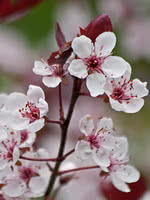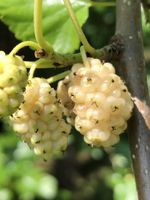Mon-Fri 9am - 5pm Mountain time
Purple Leaf Sand Cherry vs Russian White Mulberry
Prunus x cistena
Morus alba tatarica
CUSTOM GROW
NOT AVAILABLE THIS SEASON - MIGHT RETURN
Purple Leaf Sand Cherry provides bright reddish-purple leaves that turn bronze-green in the fall. In the spring, tiny flowers with a pinkish white hue bloom. The flowers are small, but the impact comes from the shrub blossoming all at once.
The Purple leaf sand cherry can be susceptible to pests and diseases in more humid areas; a typical life span is approximately 15 years. Not suitable for a privacy hedge on its own but is often alternated with lilacs. Often used as an accent plant that attracts birds and bees.
Russian White Mulberry is a cold hardy and adaptable tree. It is a great choice for the impatient gardener as it reaches its mature height in a short period of time and has an attractive, dense, and rounded form.
Odd looking berries are produced among a backdrop of glossy, deep green foliage. The blackberry-esque berries ripen slowly over the season, ranging in color from white, pink, and purple-violet. While the berries are not well regarded for fresh eating, they have made tasty jams and preserves.
Purple Leaf Sand Cherry Quick Facts
Russian White Mulberry Quick Facts
Toxicity: the leaves and seed are slightly toxic

